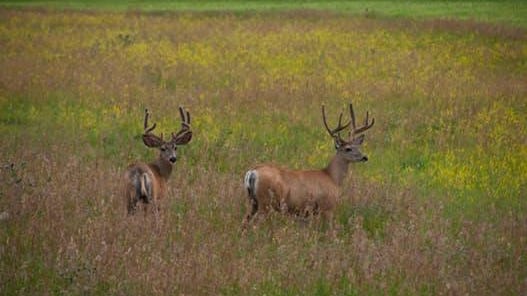Pa Wild Life Laws on Feeding Wild Animals

WEST MIFFLIN — Gary Livingston has one thing to say to the Pennsylvania Game Commission about its proposal to ban big game feeding: Try and stop me.
"They're going to have to take me to jail because I've been doing it for so long. Plus, it's on my property," said Livingtson, 69, of West Mifflin.
A Vietnam veteran with post-traumatic stress disorder, Livingston lives on 18 acres not far from the Allegheny County Airport. The area is populated with white-tailed deer and wild turkey, both of which come on his property to feed on the 700 pounds of corn he puts out weekly.
Livingston said feeding and watching the wildlife is therapeutic for him. "I'd rather be around these animals than people," he said.
The state Game Commission wants to ban what Livingston is doing — a pastime for tens of thousands of Pennsylvanians who live in semi-rural areas — because of the belief that it leads to the unnatural congregating of animals and the spread of disease.
"Disease transmission is probably at the forefront of the issues related to wildlife feeding. Habituation is another," said Mike Steingraber, state game warden supervisor for the commission's North Central Region.
Habituation is defined as the tendency for wildlife to become less wary of humans, while at the same time becoming dependent on humans, he said. Habituation also leads to nuisance problems in areas where people live and safety problems on roadways.
But the biggest concern driving the wildlife feeding proposal is the spread of chronic wasting disease, or CWA. The progressive, fatal disease has been found in the wild deer population in 10 of Pennsylvania's 67 counties.
The escalation of the disease in Pennsylvania over the past decade has prompted state game authorities to set up Disease Management Areas, or DMAs, where specific hunting regulations apply and where wildlife feeding is illegal. The game commission recently expanded DMA 2 to include most of Somerset County and a small portion of northeast Westmoreland County.
In addition to enlisting the help of hunters, the state wants the public to be more aware of how wildlife feeding affects animal behavior and can have unintended consequences.
"We all know it's a fact (that) when you congregate any species in an area, the threat of disease transmission goes higher," said Patrick Snickles, state game warden supervisor for the commission's Southwest Region.
The feeding ban proposal was tol be discussed at a public meeting Wednesday at the Delmont Volunteer Fire Department. If enacted, it would extend the current ban on feeding bear and elk to include deer and turkey.
"It's a contentious issue, but it's an important issue that needs to be addressed," Steingraber said.
Favorite pastime
One of the reasons a ban is being discussed is because wildlife watching, facilitated by wildlife feeding, is a favorite hobby for millions of Americans.
In 2016, an estimated 59.1 million Americans engaged in some form of wildlife watching tied to wildlife feeding, whether with bird feeders or some other form of feeding, according to the 2016 National Survey of Fishing, Hunting and Wildlife-Related Recreation by the U.S. Fish & Wildlife Service.
Of that number, 97% fed wild birds and 25% fed other wildlife, according to the survey.
While wildlife baiting — the practice of using food for the express purpose of hunting the deer that come — is already illegal in Pennsylvania, wildlife feeding is the favorite practice of many non-hunters, Snickles said.
"A lot of people just enjoy the aesthetics of having deer in the yard. They like to feed deer so they can see deer," Snickles said.
Livingston, the Vietnam veteran, buys corn in 50-pound bags from Pritts Feed Mill in Mt. Pleasant. The feed mill also sells a "sweet feed" that is popular with deer watchers, said owner Willy Pritts. Sweet feed contains, among other things, corn, oats and molasses.
"All the stuff they eat out in the field," he said.
Pritts said wildlife feeding is more popular than ever, and trying to curtail it is an exercise in futility. Sales of deer feed at his mill have increased by 20% in the last 10 years, he said.
"There's more people feeding deer because they like to see the deer than there are hunters feeding deer," he said. "There's more animal lovers than animal hunters anymore — even if the Pennsylvania Game Commission won't admit it."
While Pritts said he's neutral on the proposed feeding ban, he doesn't see how it can be enforced or how it will change deer behavior. For one thing, because of the spread of suburbia and people's penchant for moving to the "country," it's too late to stop the habituation of deer, he said.
"The deer have learned to look both ways before crossing the road," he said.
Pritts believes overpopulation is the real issue and that education, not regulation, is the best way to control wildlife feeding.
The proposed ban would not apply to bird feeding, food plots — small pieces of property planted with crops specifically for deer consumption — or regular agricultural activity, Steingraber said.
"There will be no change to the game commission's position on food plots — they are still an effective method of wildlife management," he said. "When you dump a big pile of food, it congregates (deer) a lot tighter than in a field of corn."
Source: https://www.yorkdispatch.com/story/news/2019/08/10/proposed-ban-feeding-wildlife-irks-some-pennsylvania/1975047001/
0 Response to "Pa Wild Life Laws on Feeding Wild Animals"
ارسال یک نظر